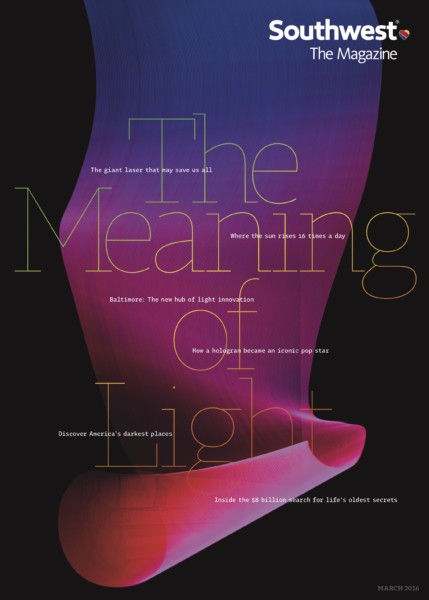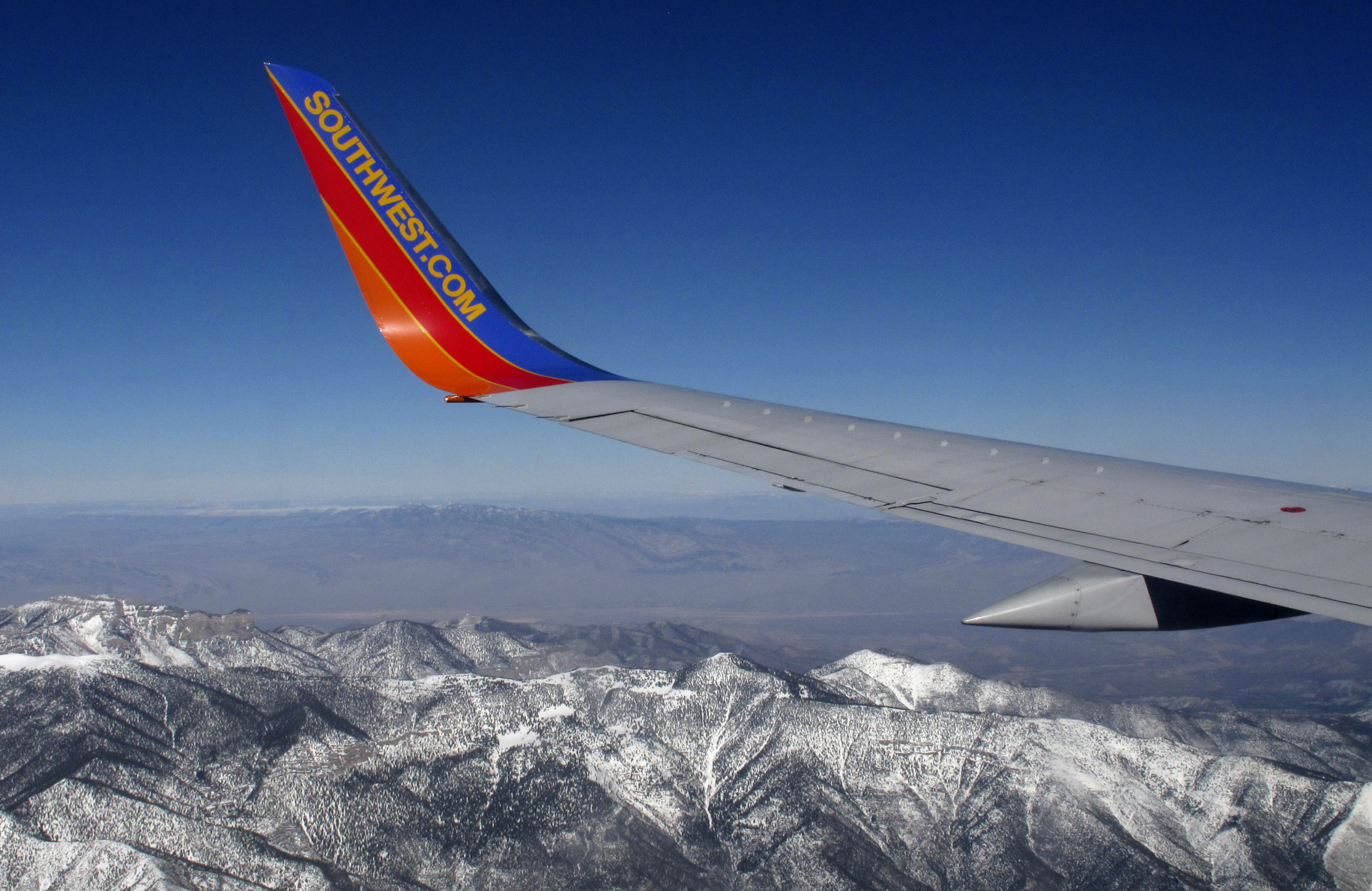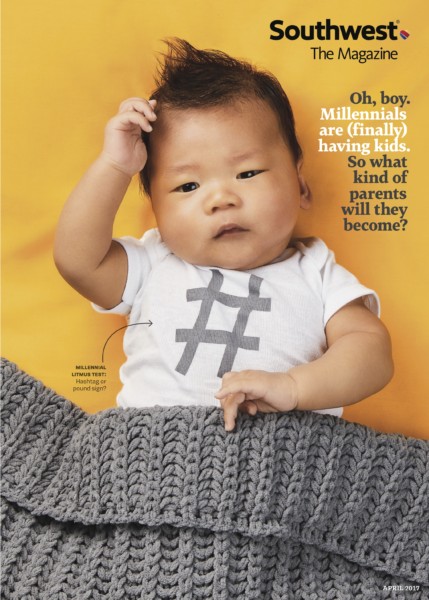In late 2015—the end of my first year as a full-time freelancer—I got a phone call most writers-for-hire dream of. On the other end of the line was J.K. Nickell, who was then senior editor at Southwest: The Magazine, the in-flight publication for the eponymous airline. Nickell and his staff had recently decided on a topic for an upcoming special issue, and he was looking for a cover story—stories, actually. He wanted me to write about light.
Light? I asked. What about light?
That’s just it, he said. Anything about light. It could be an essay on the meaning of light throughout human history, or a feature on a scientist trying to convert light into clean energy, or a profile of a holographic pop star in Japan, or an as-told-to from an astronaut aboard the International Space Station who sees sixteen sunrises a day. I should let my imagination run wild, Nickell told me—and he’d pay me a dollar per word, plus preapproved travel expenses.
I was amused and curious, but not the least bit surprised. Before it abruptly ceased publication in March, Southwest had long had the reputation of being more than your typical airplane reading material. Other airline magazines were stuffed with celebrity puff pieces and standard travel packages; Southwest, however, had once devoted an entire issue to eggs. It had published a feature about a Colorado man who, via his webcam, had found an online audience that would watch his lawn grow. The cover of its breakfast issue, built around a heartfelt essay about the author’s experience crabbing with his little brother, depicted a live crab scaling a stack of syrup-dripping pancakes.

Courtesy of Southwest: The Magazine
In the writing community, Southwest’s folding leaves a hole much larger than the extra space in seat-back pockets. “There were a lot of people who had stories they wanted to write that were a little too offbeat for your traditional glossy magazine,” says Nickell, who left Southwest in 2017 for Texas Monthly, where he’s now features director. “We became a home for those pieces and developed a distinctive voice.”
Southwest’s unconventional approach was in its DNA. In 2004, Pace Communications, a Greensboro, North Carolina–based marketing firm, was among a handful of companies bidding for the job of producing Southwest Airlines’ in-flight magazine, then called Spirit. Along with production costs, the publisher paid for the privilege to put its work, and any advertising it sold, before more than three million fliers a month. Pace brought in Jay Heinrichs, formerly an editorial director at Rodale, to consult on the bid. Heinrichs saw that Pace was the only non-Texan group pitching to the Dallas-based company and decided that he needed something to differentiate his proposal. He pulled a couple of all-nighters and put together a ninety-six-page mock-up complete with eighty pages of editorial content—actual stories, not the typical Latin dummy text.
“I just made shit up,” says Heinrichs. The airline had a largely female demographic, he says, and so he wrote a personal essay he attributed to a female writer, “who took this trip down the Connecticut River in a canoe with two friends that had grown distant after something tragic had happened to one of them. I knew I had to do a piece of narrative nonfiction that would be moving.” The mock-up, printed in bright color on an offset press, moved Southwest to give the job to Pace on one condition—that Heinrichs stay on as editor. He called every writer he knew and told them, “I want to know what you can’t sell.”

Courtesy of Southwest: The Magazine
More than a decade of harmonious relations ensued. Every month, Heinrichs would present the next month’s proposed issue in full to the airline marketing brass—who, he says, never offered much in the way of pushback. The team tended to stay on-brand: Each month, staff recruited a food photographer to shoot a cocktail from watering holes along the Southwest flight path in honor of Herb Kelleher, the airline’s eccentric, cigarette-smoking, cocktail-toting founder. “The magazine always had sort of strange ambitions,” Bradford Pearson, author and Southwest features editor from 2015 to 2018, says. “Southwest always portrayed itself as a different kind of airline. So the magazine always had that weird edge to it.”
The true beneficiaries of this arrangement—in addition to airborne readers, of course—were writers like me who now had an outlet for ideas that didn’t fit anywhere else, and access to editors who stirred our creativity with broad, provocative solicitations for pitches. We were “free to move about the country,” as the old Southwest ad said—though, as I had to explain to more than a few bewildered sources and subjects, we didn’t get free flights. (In fact, since Pace was an independent contractor and constantly watching costs, we always took the cheaper fares, regardless of the logo on the tail fin.)

Courtesy of Southwest: The Magazine
Best of all was our access to millions of readers, which was more than just a sales line for ad execs. We knew that people from all over the world read our stories. They told us so, in droves. “I got so many delightful emails from people on that plane,” says Kim Cross, author and freelance writer. “The ones I liked the most were the random readers who said they were crying on the airplane in public. A lot of them related their own story. I felt a connection that I didn’t have with readers of other magazines.”
Courtesy of Southwest: The Magazine
Cross remembers answering a typical Southwest call for pitches “about fishing and time” with an idea for a personal essay about growing up angling with her father—a story that she had gradually built up in her mind over the seven years since he died of small-cell lung cancer. The piece, which was eventually anthologized in The Best American Sports Writing 2016, drew dozens of letters and emails from readers. One read the essay while on a flight to see her own father, and wrote to Cross during her return trip. Cross’s story, the reader wrote, had led to one of her best visits with her father in ages. “That’s why I write,” Cross says. “I write to have those connections with other people.”
Southwest readers were a captive audience, suspended thirty thousand feet above the world, scrunched in with all those other fliers, anonymous. Its stories caught them at a singular moment, Nickell believes. “There’s something about when you get on an airplane,” he says. “You’re missing time with your family, or you’re going to visit family. You’re on your way to a job interview, or going on a vacation. These are all milestones. I think it opens you up to experiences in a different way. When you tell those types of stories in that kind of environment, people respond.”
NEW AT CJR: Stop using ‘officer-involved shooting’
Tony Rehagen has written for Pacific Standard, GQ, Bloomberg, and ESPN The Magazine. He is based in St. Louis and is on Twitter @trehagen.




